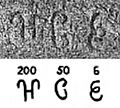6 (number) facts for kids
This page is about the number six. For the year, see 6
Quick facts for kids
|
||||
|---|---|---|---|---|
| Cardinal | six | |||
| Ordinal | 6th (sixth) |
|||
| Numeral system | senary | |||
| Factorization | 2 × 3 | |||
| Divisors | 1, 2, 3, 6 | |||
| Greek numeral | Ϛ´ | |||
| Roman numeral | VI | |||
| Roman numeral (unicode) | Ⅵ, ⅵ, ↅ | |||
| Greek prefix | hexa- / hex- | |||
| Latin prefix | sexa- | |||
| Binary | 1102 | |||
| Ternary | 203 | |||
| Senary | 106 | |||
| Octal | 68 | |||
| Duodecimal | 612 | |||
| Hexadecimal | 616 | |||
| Greek | στ (or ΣΤ or ς) | |||
| Arabic | ٦ | |||
| Persian | ۶ | |||
| Urdu | ||||
| Amharic | ፮ | |||
| Bengali | ৬ | |||
| Chinese numeral | 六,陆 | |||
| Devanāgarī | ६ | |||
| Hebrew | ו (Vav) | |||
| Khmer | ៦ | |||
| Thai | ๖ | |||
| Telugu | ౬ | |||
| Tamil | ௬ | |||
The number six is a natural number that comes after the number five and before the number seven. Six is also the first perfect number which means that the sum of its factors (1, 2 and 3) are equal to the number itself (6). The next perfect number is 28. In Roman numerals, it is VI.
Mathematics
In mathematics, the number six is an even number.
Images for kids
-
A cube has six faces.
-
X-ray of a polydactyl human hand with six fingers
-
The first appearance of 6 is in the Edicts of Ashoka circa 250 BCE. These are Brahmi numerals, ancestors of Hindu-Arabic numerals.
-
The first known digit "6" in the number "256" in Ashoka's Minor Rock Edict No.1 in Sasaram, circa 250 BCE
-
The cells of a beehive are six-sided.
See also
 In Spanish: Seis para niños
In Spanish: Seis para niños

All content from Kiddle encyclopedia articles (including the article images and facts) can be freely used under Attribution-ShareAlike license, unless stated otherwise. Cite this article:
6 (number) Facts for Kids. Kiddle Encyclopedia.





